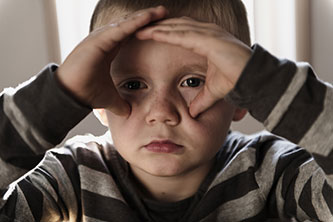Phone: 252-636-1919





Here you will find educational articles on topics relating to your family’s health. Click here for our articles archive.

Childhood itself can be quite an angst-ridden process. Children are expected to learn new skills, meet new challenges and overcome certain fears. The stressors and pressure of trying to navigate in a world that doesn’t always make sense may lead to the development of anxiety in a child.
Anxiety is a normal emotion and often a healthy emotion. However, when a child feels excessive levels of anxiety, it could lead to a medical disorder. Anxiety disorders cause extreme fear and worry, and changes in a child’s behavior, sleep patterns, eating, or overall mood. According to the website www.kidsmentalhealth.org, one in ten children suffer from an anxiety disorder. There are many types of anxiety disorders, but the following are the most common anxiety disorders experienced by children.
Generalized Anxiety Disorder (GAD) is severe ongoing anxiety that interferes in daily activities. Children with GAD worry over things that most kids worry about, such as homework, tests, or mistakes, but to an extreme level. Having GAD can make it difficult for kids to focus in school, because worry invades the child’s mind and mental process. GAD makes it difficult for kids to relax and have fun, eat well, or fall asleep at night. They may miss many days of school, because worry makes them feel sick, afraid, or tired.
Separation Anxiety Disorder (SAD) occurs when a child becomes extremely anxious when separated from her parent. It’s normal for young children to feel anxious the first time they are separated from a parent. But when kids don’t outgrow the fear, they may be experiencing SAD. Children with this disorder may frequently worry about their parents dying or becoming separated from them. They may cling to a parent, cry, or refuse to go to school, sleepovers, play dates, or other activities without a parent.
Social Anxiety Disorder or social phobia is a disorder in which social interactions cause irrational anxiety. With social phobia, kids feel too afraid of what others will think or say about them. They are always afraid they might do or say something embarrassing. Children may exhibit this fear through throwing tantrums, crying, clinging to adults, freezing up in a group, or refusing to speak. They may also feel shaky and lightheaded and may avoid social situations that could provoke this fear.
Selective Mutism (SM) is a complex childhood anxiety disorder characterized by a child's inability to speak and communicate effectively in select social settings, such as school. Kids with SM can talk; however they refuse to talk at school, with friends, or in other places where they have this fear. Children around the age of 5 are most commonly diagnosed with this disorder.
Specific phobia is any kind of anxiety disorder that amounts to an unreasonable or irrational fear related to exposure to specific objects or situations. It’s normal for young kids to feel scared of the dark, monsters, thunder, or fireworks, but with a phobia, it’s more extreme. If this fear lasts a long time and is out of proportion to the actual danger posed, it could be classified as a phobia. A phobia may cause adolescents to avoid going places where they think they may see the thing they fear.
Several factors can play a role in causing the overactive “fight or flight” that happens with anxiety disorders. It can be genetics, brain chemistry, life situations, or learned behaviors. Most often, anxiety can be treated.
Sources:
Kidsmentalhealth.org
Kidshealth.org
Psycom.net